
There are few things as sad as a crested gecko whose
There is a very wide variety of real plants that you can choose from for your crested gecko’s
Here’s our list of awesome plants that are perfect for your crested gecko’s
But first, let’s look at the pros and cons of using live plants instead of fake plants for your crested gecko.
The Pros And Cons Of Using Real Or Fake Plants In Your Crested Gecko’s Tank
| Using Real Plants For Your Crested Gecko | |
| Pros | Cons |
| Your crestie will get a more natural habitat to live in | Some plants need a lot of TLC |
| They will have a lot of space to exercise and explore – especially if you change the setup when you deep clean the | You have to water them relatively often, which means that you need to keep a closer eye on the |
| You will spend more time with your crestie while keeping their forever home neat and tidy | You need to prune them often to ensure that they don’t take over the |
| If they do chew on a leaf or two, they won’t be ingesting fabric or plastic | You need to know which plants are safe and which are toxic to cresties |
| Using Fake Plants For Your Crested Gecko | |
| Pros | Cons |
| You don’t have to water them, which makes it easier to keep the | They may ingest some of the fabric or plastic by accident |
| You don’t have to prune them | They can become tatty after a while |
| You don’t have to worry about them taking over the | If you need a bigger plant, you need to buy a bigger one instead of simply waiting for it to grow |
| You can easily rearrange the plants without them dying | Your crestie can get bored with the plants because they always look the same |
24 Plants That Are Safe To Use In Crested Gecko Tanks
Here is an alphabetical list of the plants that are safe to use in crested gecko tanks, including details about each plant’s size, upkeep, and more.
Creeping Wire Vine (Muehlenbeckia complexa)
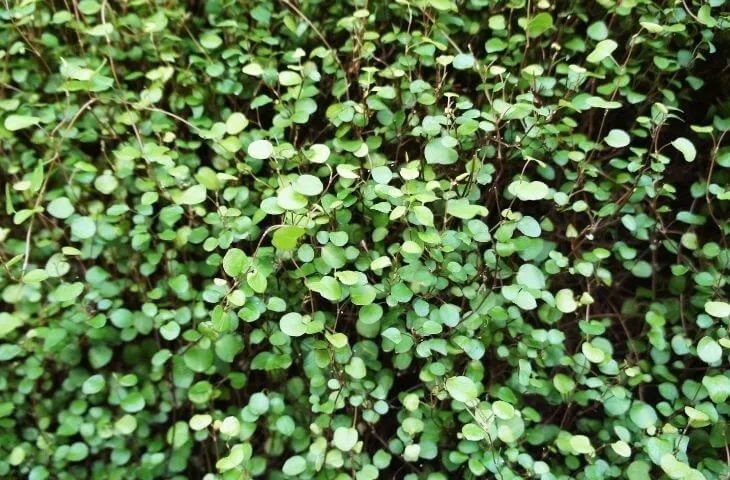
A native of New Zealand, the creeping wire vine/angel vine has long, wiry tendrils and small, delicate leaves that makes it ideal as a filler for a crested gecko
Angel vines like humidity, which means that they’ll thrive in a crested gecko
Angel vines prefer indirect light, so don’t plant them in the warmest part of the
You’ll also need to trim the angel vine relatively often, as the tendrils can grow to be more than 12 feet long if left to themselves.
Bird’s Nest Fern (Asplenium nidus)
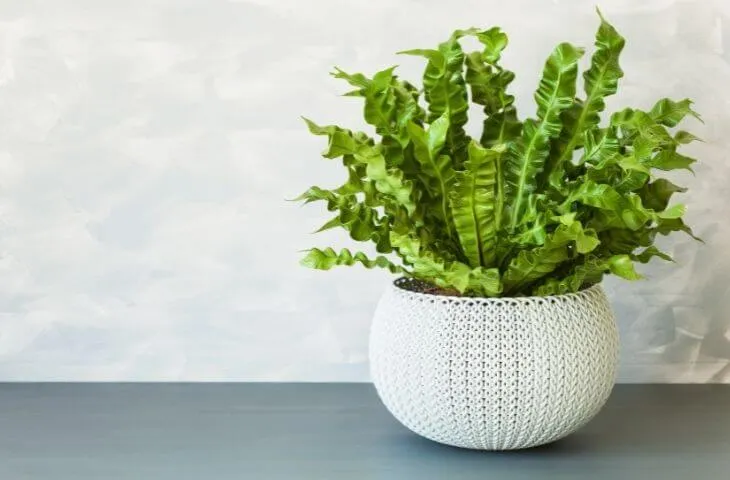
The bird’s nest fern is a beautiful bright green fern that has large leaves that make for ideal hiding spots for when your crested gecko wants to cool down a bit.
As it likes the level of humidity in the cresties’ tanks and prefers moist soil, it’s best planted away from the basking spot and next to the cool hide.
The leaves of this fern can grow to be quite large, so you’ll need to prune it to keep it from getting too big for the
Bromeliads (Neoregelia sp.)

Bromeliads come in a wide variety of colors and can be used to great effect in your crested gecko’s
You can give them a cork or bark base to grow on and to stabilize them for when your crestie climbs around on them.
Great bromeliad additions to your crested gecko
- Billbergia
- Cryptanthus
- Guzmania
- Neoregelia
- Vriesea.
Chinese Evergreens (Aglaonema)
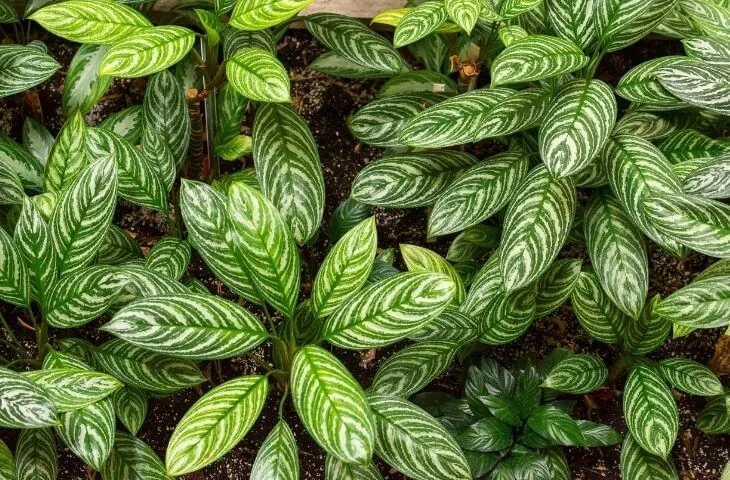
The Chinese evergreen is a fast-growing, beautiful plant that has green and white leaves. It is sturdy enough for your crested gecko to climb on and makes a great focal point when planted at the back of the
Just remember that the Chinese evergreen likes humidity but doesn’t like too much water, so make sure that the soil dries out a bit between watering.
As far as low-maintenance crestie plants go, this is one of the plants that you can mostly just leave alone and prune when necessary.
Concinna Prayer Plant (Calathea concinna)
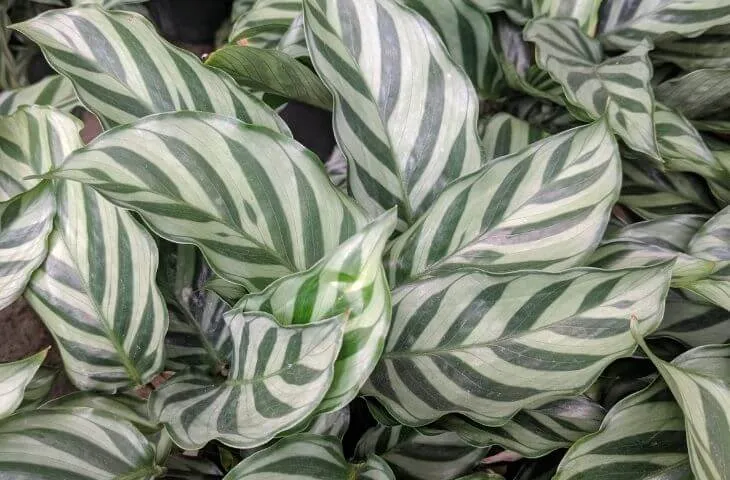
The concinna prayer plant – so called because the leaves open and close in the morning and evening like hands in prayer – has dark, waxy leaves and thrives in a humid environment.
The prayer plant does need more TLC than some of the other plants on this list and, when watering, make sure that you keep the well-draining soil moist, but the leaves dry.
Creeping Fig (Ficus pumila)
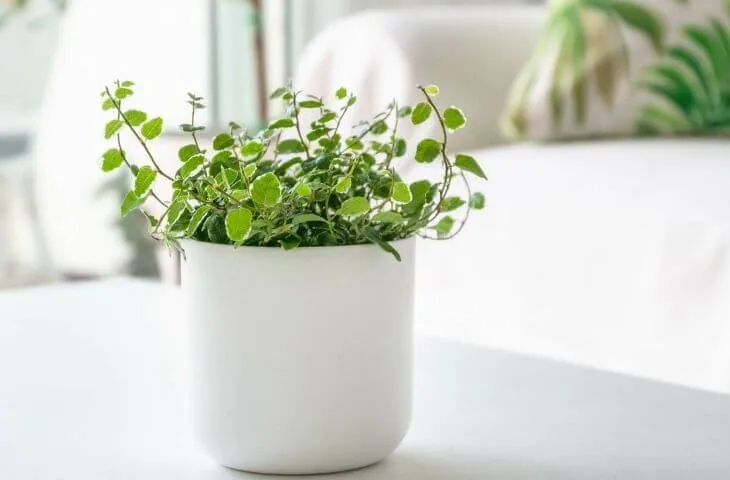
This creeper is ideal for use at the back of the
When we say it thrives in humid conditions, we actually mean that you’ll need to trim this creeper very often to keep it in check and not let it take over the whole
Dwarf Umbrella Tree (Schefflera arboricola)
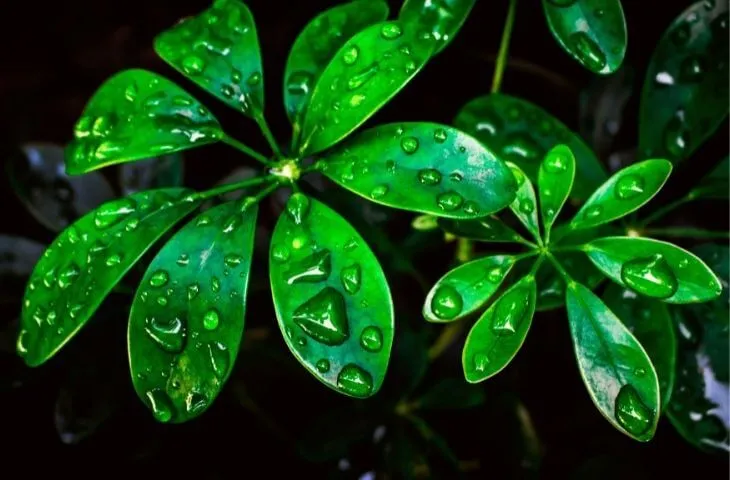
This smallish tree with its fanned clusters of leaves (hence “umbrella”) and sturdy trunk is ideal for crested gecko clambering and climbing. It enjoys the humidity of the crested gecko
Plant it on the cooler side of the
Elephant Ears (Alocasia polly)
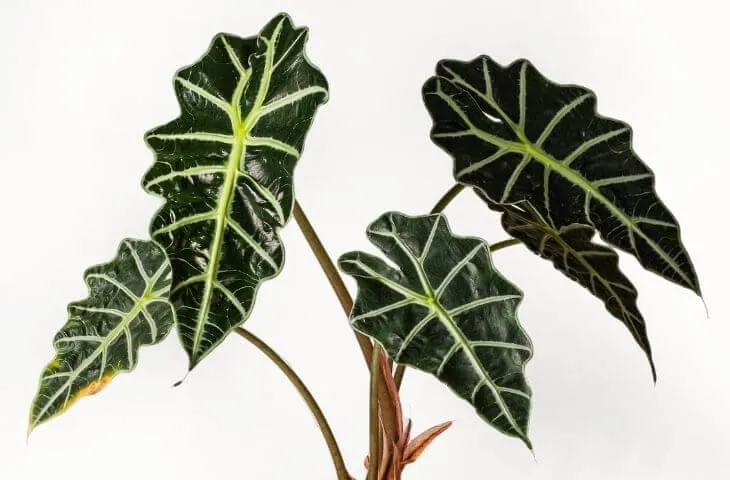
Elephant ears have large leaves on sturdy stalks that are excellent for cresties to climb and bask on. While the plant is usually dark green with silver-white veins, some of the types of elephant ears do come in other colors.
It should be noted that the elephant ear needs quite a lot of TLC and isn’t a great plant for beginners to have in a crestie’s
Goosefoot/ Arrowhead (Syngonium)
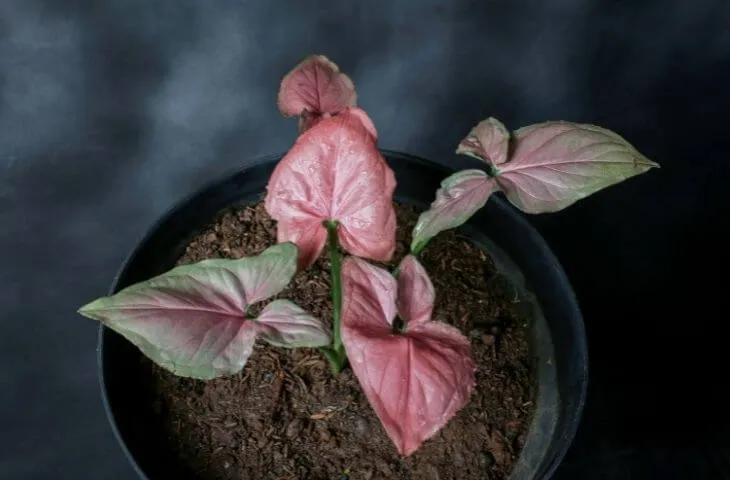
Another awesome – and quite easy to take care of – plant for your crested gecko’s
Tip: If you’re looking for the goosefoot variety that contains pink, ask for the “Pink Syngonium” and “Neon Robusta” varieties.
Although this plant is really easy to grow, it does require quite a bit of maintenance as it’s a fast grower that loves to spread out.
With some help from dried bamboo to grow against and around, you can make a great vertical climbing surface for your crested gecko.
Goosefoot prefers indirect light and should be allowed to dry a bit between watering. Water about once or twice a week, depending on the size of the plant – the larger the plant, the more thirsty it’ll be.
Jade Jewel (Dracaena fragrans)

The jade jewel plant is another favorite for crested gecko tanks. Its large leaves may seem floppy, but they’re actually large enough and sturdy enough for a crested gecko to climb around on.
It also tolerates different levels of light well, so you can plant it anywhere in the
Unlike some vivarium plants, the jade jewel is slow-growing, meaning that you won’t need to give it that much TLC even if your crestie is climbing about on it the whole day. Also, make sure that the soil that your jade jewel is planted in drains well.
Lemon Button Fern (Nephrolepis cordifolia)
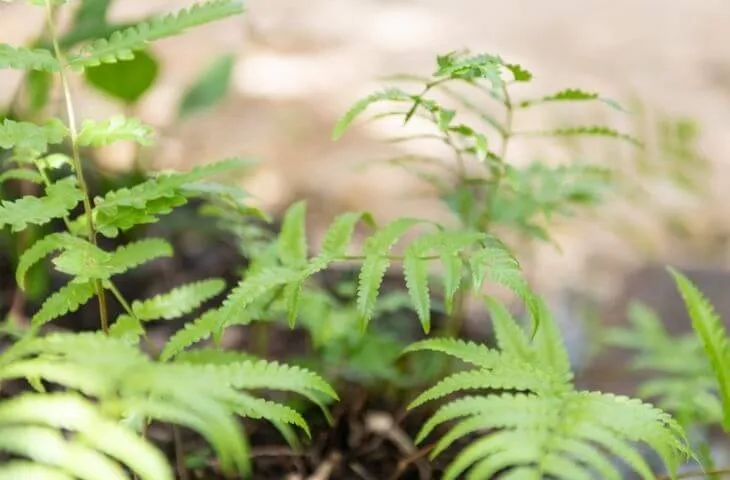
The lemon button fern gets its name from its lemon scent and leaf shape. However, this plant is more for hiding and for show as the stems aren’t strong enough for your crestie to climb on.
The fern should also grow well if you keep it moist (but not wet) and keep it trimmed so it doesn’t take over the
Lucky Bamboo (Dracaena sanderiana)
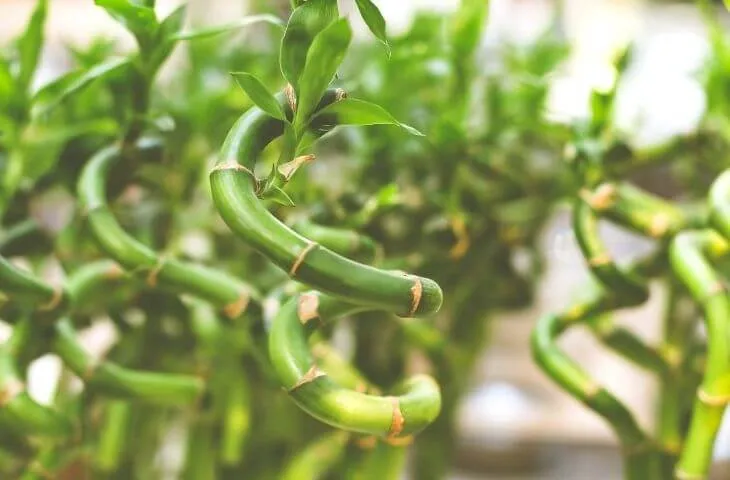
It is safe to use lucky bamboo in a crested gecko’s
These are easy to clean as well!
Lucky bamboo (which is actually a type of grass!), which is native to Africa, makes an ideal structural plant and focal point for your crested gecko’s
These succulent-like plants are ideal for your crested gecko to climb on and can serve as a “ladder” between plants of different heights in your crestie’s
Snake Plant (Sansevieria laurentii)
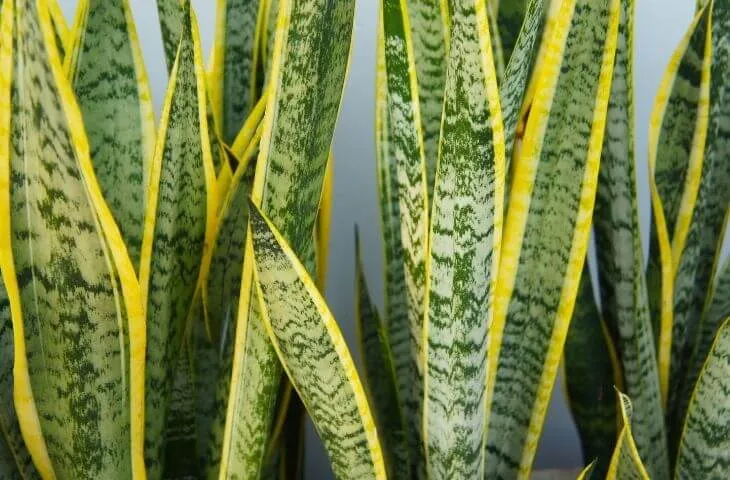
The Snake Plant /Mother-in-law’s tongue has straight, sword-shaped leaves that are green and creamy-white. It’s low-maintenance, but grows to a large and tall size; therefore they should only be planted in large crested gecko tanks.
Although your crestie won’t be able to climb around on the snake plant, it does serve as a great hiding place and can always be used as a focal point at the back of your crested gecko’s
Peace Lily (Spathiphyllum)
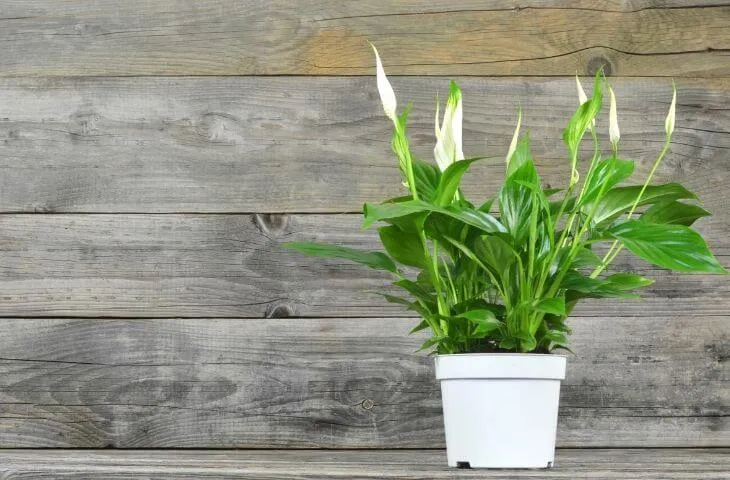
The peace lily is able to thrive in many different temperatures and light and isn’t toxic to crested geckos, which make them ideal for crestie tanks and then also for beginner live plant keepers.
When using the peace lily in your crested gecko’s
Petra (Codiaeum variegatum)
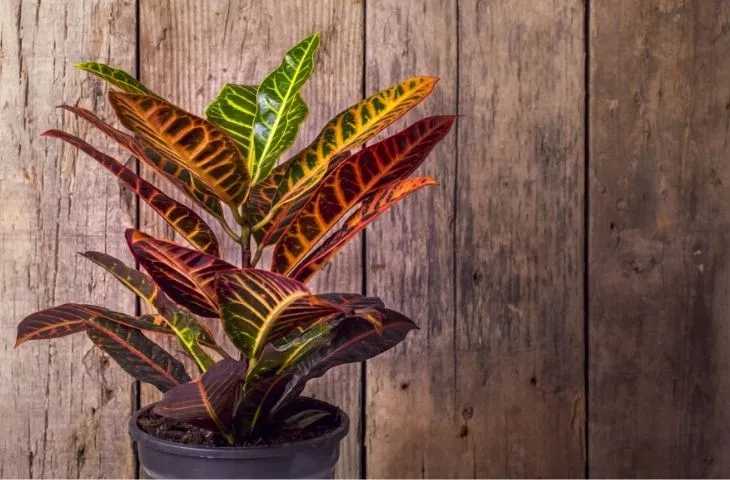
The striking petra has variegated foliage that will add immediate color to your crested gecko’s
Because of the petra’s size, it should be planted at the back of the
Pillow Moss/Cushion Moss (Leucobryum glaucum)
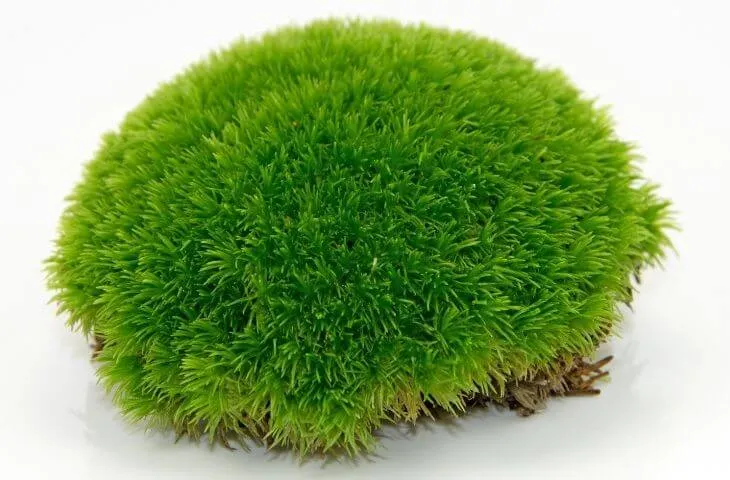
Pillow moss really looks like their name implies and these squishy cushions are ideal for your crested gecko’s
Your crestie can also nibble on the moss – and some cresties really like doing that.
Pink Quill (Tillandsia cyanea)
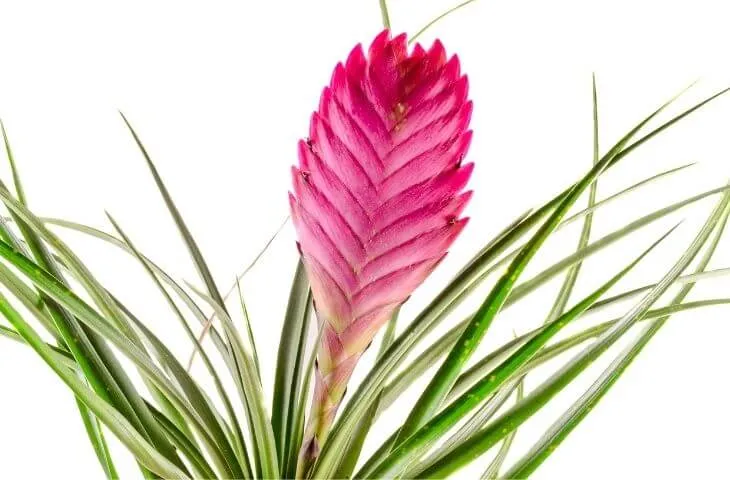
If you’re looking to add some bright color to your crested gecko’s
They also won’t wilt in the humid environment of your crestie’s
Pothos/Devil’s Ivy (Epipremnum aureum)
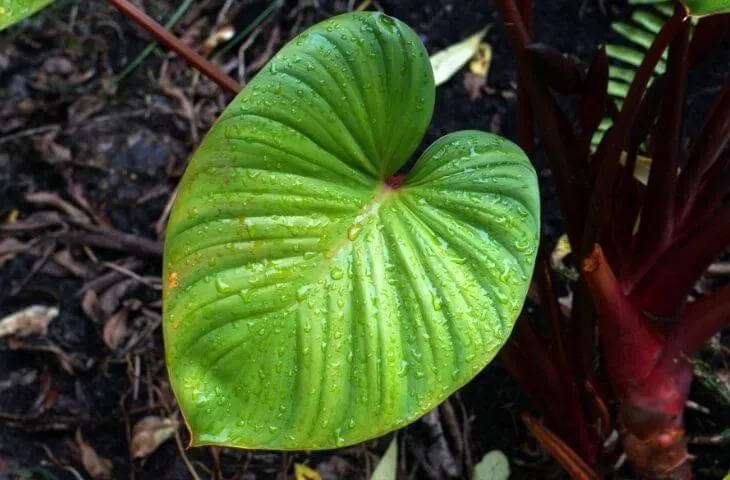
The pothos or devil’s ivy is a rapid-growing vine that has bright green leaves. Low growing, it makes for excellent hiding places for your crested gecko when they want to escape the heat for a while.
This is one of the most popular plants for crested geckos and looks really good when planted more to the side of the
Although pothos mostly provide shelter, its low vines are ideal for your crestie to clamber on.
Rabbit’s Foot Fern (Davallia/Humana tyermanii)
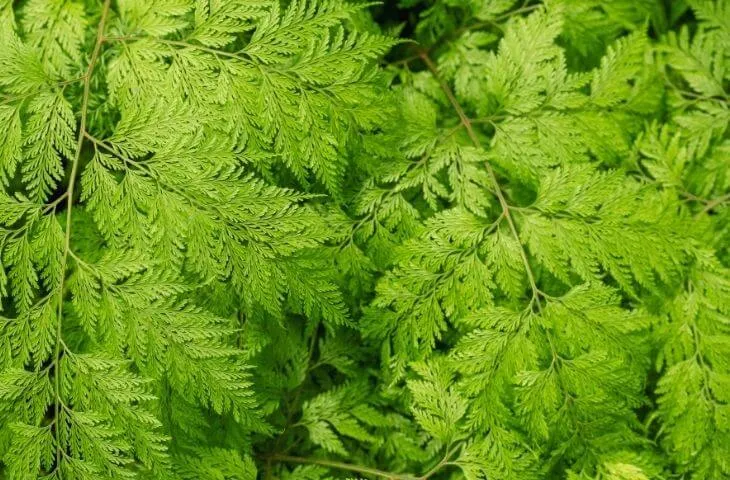
The rabbit’s foot fern is a beautiful, light green fern that grows about 5” tall. It can be planted as a terrestrial or grown as an epiphyte (grown on another plant like a weeping fig or dwarf umbrella tree).
Its rhizomes are furry and silver-white in color, and, when planted on a darker plant or pot, will look striking. The rabbit’s foot fern should remain moist, but not wet. Plant it away from direct light as well.
Radiator Plant (Peperomia)
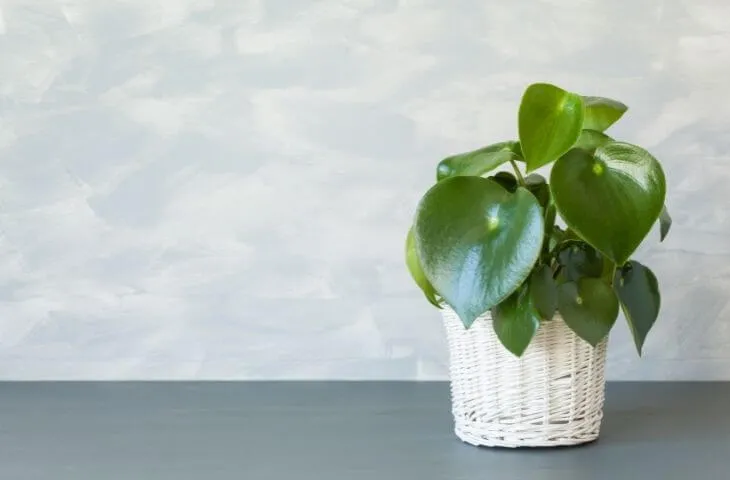
Radiator plants only grow to about a foot tall, making them the ideal size for a crested gecko’s
The dark green-black leaves of the radiator plant can look very striking when planted between the light and lime green leaves of ferns, goosefoot, etc. Give it indirect light and keep it moist, but not wet.
Spider Plant (Chlorophytum comosum)

Spider plants are very adaptable and will make a great addition to your crested gecko’s
Most spider plants are white and green, although there are now also variegated varieties that are just as easy to care for.
Weeping Fig (Ficus benjamina)
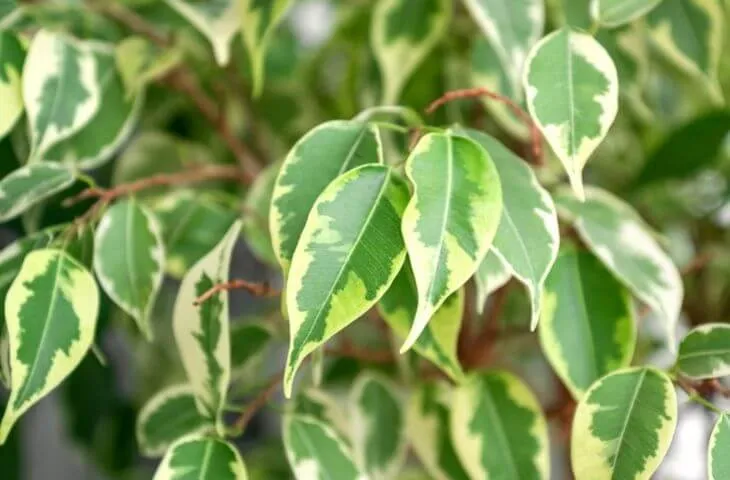
The weeping fig is more there for making your crested gecko’s
Your crestie will be able to climb up the trunk, so ensure that you arrange the
Zebra Plant (Calathea zebrina)
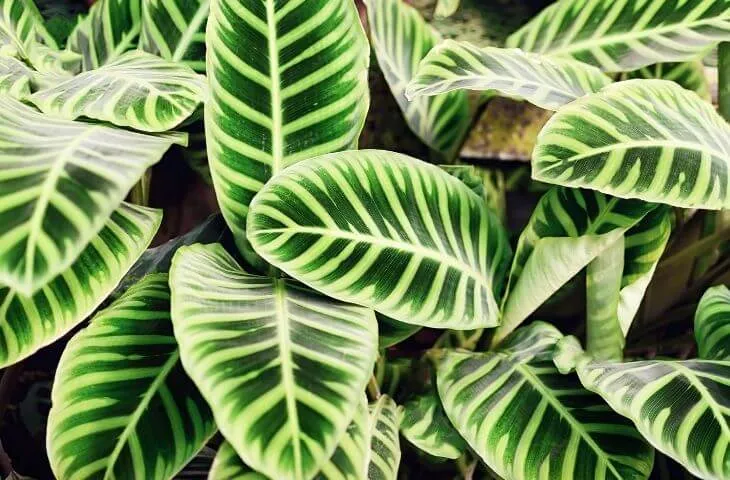
Not to be confused with the prayer plant, this native of Brazil can grow quite large (6ft. x 3ft.) and is only suitable for the largest of crested gecko tanks.
Some of the varieties have leaves striped in yellow or pink, making them even more striking as a display piece in your crestie’s
Keep your zebra plant in check through trimming and give it indirect or diffused light to thrive. Don’t overwater it, and check that the soil drains well.
It also helps to maintain the humidity in the
11 Plants You Should Never Put In A Crested Gecko’s Tank
- Begonias (Begonia)
- Braken Fern (Pteridium aquilinum)
- Calla lily (Zantedeschia aethiopica)
- Cycads
- Dumbcane (Dieffenbachia)
- Hyacinth (Hyacinthus orientalis)
- Ivy (Hedera spp.)
- Mistletoe (Phoradendron villosum)
- Philodendrons
- Poison ivy (Toxicodendron radicans)
- Voodoo lily (Dracunculus vulgaris)
All these plants are either not a good fit for a crested gecko
Still, that is no problem at all since we showed you that there are more than enough plants that are a good fit for your crestie
How To Choose Which Plants To Use In Your Crested Gecko Tank
Having this long list of plants that you can use in your crested gecko’s
However, there is a relatively simple way to choose which plants are the best for your crested gecko.
First of all, you need to take into account the age of your crested gecko and then you need to take into account the size of your crested gecko’s
The Age Of Your Crested Gecko
Although your crested gecko will always want to climb, you can rather opt for smaller plants while your crestie is a baby or juvenile.
Once they’ve reached adulthood, you can then change up the
A baby crested gecko can hide beneath smaller plants and thinner vines and stems are able to support their weight. If you use smaller plants like angel vine, you will also be able to find them easier!
An adult crested gecko will then need larger plants to support their weight when they climb around and go exploring. They will love petras, elephant ears, mother-in-law’s tongue, and bird’s nest fern.
The Size Of Your Crested Gecko’s Tank
When choosing a
To only give them a horizontal
A crested gecko’s
A completed setup of a crested gecko’s
Note! Make sure that you only use sterilized wood in your crested gecko’s
tank . This will ensure that you don’t bring any pests or diseases into your crestie’stank by accident.
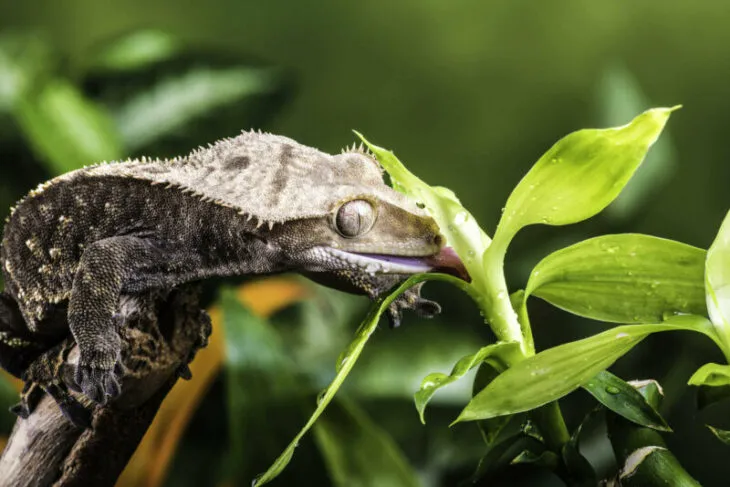
Can You Use Potted Plants In Crested Gecko Tanks?
Yes, you can use potted plants in your crested gecko’s
If you do decide to use potted plants, you should ensure that you use good-quality pots instead of just any old container.
One of our favorite types of pots to use in crested gecko tanks are terracotta pots. These pots are not only hard-wearing, but they also retain moisture much better than plastic pots.
As most of the plants that are used in crested gecko tanks need to remain moist, using clay pots like these are ideal.
Using pots also makes it a lot easier to remove the plants when you’re cleaning your crested gecko’s
Start with small pots and then get larger pots as needed, hiding them in the substrate, behind hides, etc.
Tip: When a plant in your crested gecko’s
tank becomes too big, you can always just remove it and keep it either as a house plant or plant it in your garden.
Using A Heat Mat When You Have Real Plants In Your Crested Gecko’s Tank
An important thing to note when using real plants in your crested gecko’s
Although heat mats are often put underneath a
If you want to or need to use a heat mat in your setup as well, you will need to place it on the side of the
You should also make sure that you really need to use a heat mat for your crested gecko before buying one.
Why You Should Know Your Plants’ Maximum Temperature And Humidity Tolerance
When you’re choosing plants for your crested gecko’s
For example, you will need to plant ferns on the cool side of the
Plants that are more succulent-like can then be planted on the warmer side of the
You also have to keep in mind that the plants you use in your crested gecko’s
However, with the use of real plants in a crested gecko’s
Tip! If you use real plants in your crested gecko’s
tank , make sure that you get a good quality hygrometer that will give you ongoing accurate measurements.
Plants’ Maximum Temperatures, Recommended Placement, and Watering Schedule
| Plant Name | Maximum Temperature | Humidity Tolerance | Recommended Placement | Watering Schedule |
| Angel Vine | 80 °F | 27 °C | 30% to 40% | Away from direct light, to the front of the | Weekly, except in winter (then once every two weeks) |
| Bird’s Nest Fern | 80°F | 27°C | 40 – 60% | Indirect, low light. Plant on the cooler side of the | Wait for the soil to dry out before watering again (every 1 to 2 weeks). Can mist between watering. |
| Bromeliads | 90°F | 32°C | 40 – 60% | Bright but indirect light – don’t plant too close to the basking spot. | Mist when the soil starts to get dry. |
| Chinese Evergreens | 75°F | 24°C | 60 – 70% | To the back on the coolest end of the | Mist regularly to keep moist. |
| Concinna Prayer Plant | 85°F | 30°C | 70% or higher | Plant in the middle of the | Mist regularly to keep moist. |
| Creeping Fig | 85°F | 30°C | 50% or higher | Plant away from the basking spot to keep the amount of direct light lower. | Keep soil moist by misting regularly, not less than once per week. |
| Dwarf Umbrella Tree | 75°F | 24°C | 50% or higher | Plant in the back corner of the cool side. | Let the soil dry slightly between watering. |
| Elephant Ears | 85°F | 26°C | 60% or higher | Plant close to the centre of the | Keep moist with deep watering once a month. |
| Goosefoot | 85°F | 30°C | 60% or higher | No direct light, so don’t plant it next to the basking spot. | Mist several times per week to keep moist. |
| Jade Jewel | 80°F | 27°C | 40 – 60% | Avoid the direct light around the basking spot; plant towards the cooler end of the | Mist regularly, but don’t get the soil more than moist. |
| Lemon Button Fern | 80°F | 27°C | 60% or higher | Plant in the middle of the | Water thoroughly before planting and then keep soil moist through misting. |
| Lucky Bamboo | 95°F | 35°C | 50% or higher | Can be planted anywhere in the | Mist often with distilled water/tap water standing more than 24 hours. |
| Mother In-Law’s Tongue | 75°F | 24°C | 40 – 60% | Plant more towards the cool side, sheltered by larger plants. | Mist once or twice per week. |
| Peace Lily | 85°F | 30°C | 60% or higher | Plant on the warm side of the | Keep moist by misting regularly. |
| Petra | 85°F | 30°C | 40 – 60% | Plant on the warm side of the | Let the soil dry slightly between mistings. |
| Pillow Moss | 80°F | 27°F | 70% or higher | Plant on the cool side of the | Mist daily to keep it moist. |
| Pink Quill | 75°F | 24°C | 50% or higher | Plant on the cool side of the | Mist to keep moist. |
| Pothos | 80°F | 27°C | 50 – 70% | Plant on the cool side of the | Let the soil dry slightly between mistings. |
| Rabbit’s Foot Fern | 80°F | 27°C | 60 – 70% | Plant in the shelter of other plants, not in direct light. | Mist to keep moist. |
| Radiator Plant | 75°F | 24°C | 40 – 50% | Plant to the front of the cool side as it shouldn’t be in the shade. | Mist every couple of days to keep slightly moist. |
| Spider Plant | 80°F | 27°C | 60 – 70% | Plant to the front of the | Keep moist through misting daily or every other day. |
| Weeping Fig | 80°F | 27°C | 60 – 70% | Plant to the back of the | Mist to keep soil moist. |
| Zebra Plant | 75°F | 24°C | 60 – 70% | Plant to the front of the cool side as it shouldn’t be in the shade. | Mist to keep soil moist. |
What To Do If The Humidity In Your Crested Gecko Tank Gets Too High
If you find that the humidity in your crested gecko’s
If you’ve just misted the
However, if it’s not a matter of having just misted the
You don’t have to keep it open long or even open it completely. Just letting some of the drier air in the room into the
Tip! If you find that the humidity of the
tank stays high, you may be misting thetank too often. Cut back on the amount of water you’re using and keep checking the hygrometer to see if the humidity stabilises at the correct level.
How To Choose A Healthy Plant For Your Crested Gecko’s Tank
Choosing the best plants for your crested gecko’s
- The leaves should be a healthy color – whether that is green or another color
- The stems should be healthy and not soft or black as this is a sign of disease or over-watering
- The root system should be well-developed when you remove it from its original pot to replant it for the
tank .
Is A Crested Gecko Plant Kit Any Good?
Whether a crested gecko plant kit is good or not usually depends on the supplier as some suppliers may not have very healthy plants. If you can’t look at the plants yourself before choosing which ones to buy, you need to make sure that you only buy from a reputable supplier.
Also, make sure that you get a good variety of plants that will not only look good but – even more important – fit in your crested gecko’s
You would also want plants that are both fast and slow-growing in order to make it easier for you to keep everything trimmed and not have them take over the whole
Many of the gecko plant kits suppliers choose the plants for you, so while you have an idea of what you’ll get, the plants may be more of a “luck of the draw” regarding type and even health.
You also won’t be able to choose the size of the plants, making it difficult to know exactly where to plant them.
If you are a beginner, however, choosing to take a crested gecko plant kit from a trusted supplier may be a very good idea as it will simply make it easier to set up the
How To Water The Plants In Your Crested Gecko’s Tank
To water the plants in your crested gecko’s
This will give the chemicals in the water time to evaporate. Then, taking care not to use too much water, spritz some or all of the plants in the
Some plants may need to be watered more thoroughly once per month. To do this, water the plants when you clean the whole
While you’re cleaning the
Conclusion
Giving your crested gecko a more realistic natural
Keeping the plants that you’ve added to the
- Enchi Ball Python: A Unique and Stunning Morph of Python regius - March 27, 2025
- Emerald Tree Monitor: The Enigmatic Green Guardian of the Rainforest - March 26, 2025
- The Egyptian Cobra (Naja haje): A Fascinating Serpent - March 25, 2025
